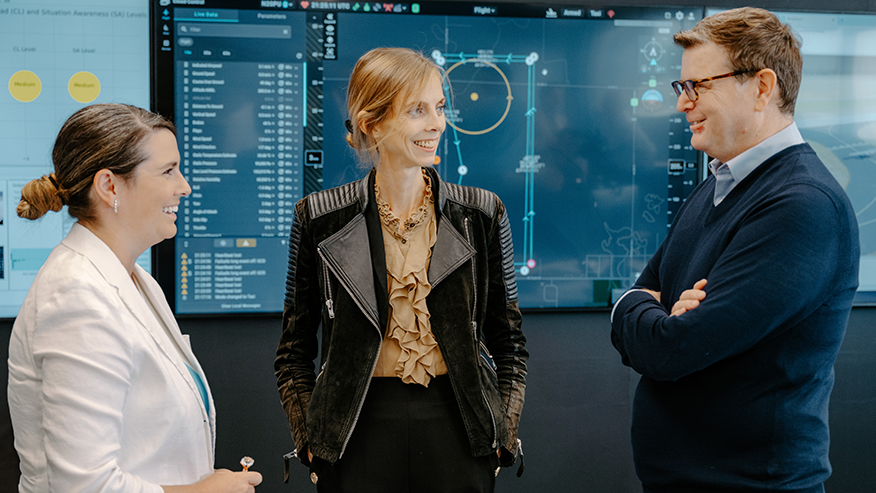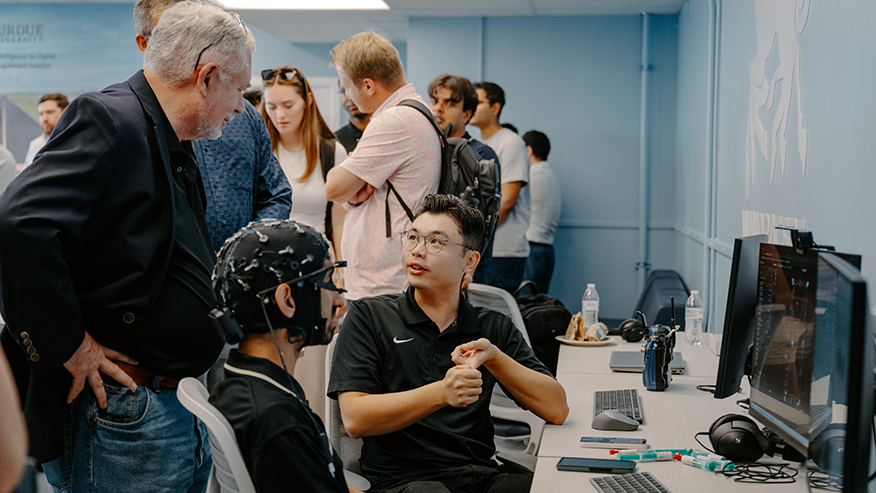Research center celebrates opening of ‘Smart Crossways’ operations center at Purdue Airport to advance UAV efforts
AIDA3-led event coincides with NSF workshop focusing on launch of new era of AIrTonomy for advancing safe autonomous aviation through AI

The Purdue-led AI for Digital, Autonomous and Augmented Aviation (AIDA3) center unveiled its Smart Operations Center (SOC) at the Purdue University Airport this week and officially launched its Smart Crossways of America effort. Discussing research and partnership possibilities at the SOC, from left, are Julia Allen, chief technology officer for Saab Inc.; AIDA3 founding director Sabine Brunswicker, a Purdue professor for digital innovation; and Simon Thompson, group CEO of UK-based Windracers. (Purdue University photo/Kelsey Lefever)
WEST LAFAYETTE, Ind. — Purdue University researchers are bringing together their collective expertise to develop the nation’s first smart air corridor.
The Smart Crossways of America, a 200-mile-long air corridor, will enable uncrewed aerial vehicles to safely transport cargo, medicine and people from Purdue’s West Lafayette campus to the Naval Surface Warfare Center, Muscatatuck Urban Training Center in southern Indiana and Indianapolis.
To kick off this effort, Purdue’s Center on AI for Digital, Autonomous and Augmented Aviation (AIDA3) on Tuesday (Sept. 10) unveiled its state-of-the-art testing facility, the Smart Operations Center (SOC) for Smart Crossways, at the Purdue University Airport during a public event attended by more than 70 people. A series of live demonstrations also showcased the capabilities of autonomous aerial vehicles (AAVs) in an urban air-mobility environment.

In connection with the operations center launch, AIDA3 led a two-day this week workshop, titled “AIrTonomy: The Smart Crossways of America,” which included industry and academic leaders focused on the development of AAVs for cyber-simulated and real-world environment. This innovative infrastructure is a primary component of a broader effort led by AIDA3 that was launched in April.
“The Smart Crossways corridor will provide the Purdue-led AIDA3 team and collaborators a key, real-world test environment as it looks to explore and foster a converging field of R&D focused on AI-enabled autonomy envisioning the future or urban air mobility,” said AIDA3 founding director Sabine Brunswicker, a Purdue professor for digital innovation.
“We call this field AIrTonomy and emphasize its vision to develop safe and trustworthy artificial intelligence and machine learning systems for AAVs to operate safely in urban environments. We want to ensure that future autonomous drones and air taxis can safely move things and people beyond visual line of sight.”
Additional Information
An essential part of this effort is the 15-mile-wide Purdue Unmanned Proving Ground, or PUP, said Karen Plaut, Purdue’s executive vice president for research. “Geographically organized within a triangle near Purdue’s West Lafayette campus, PUP brings together five unique indoor and outdoor facilities and infrastructure components that ensure research can iterate rapidly from ‘lab to life,’” Plaut said.
To ensure integration into real urban airspaces and allow vehicles to fly within PUP, the research team is working with leading defense and security company Saab Inc. to install ground communication and networking infrastructures for urban airspace management. This Purdue XTM system will utilize the state-of-the-art radar and sensor systems and will produce data that researchers can translate into innovations for urban air mobility.
“Saab is proud to support Purdue in revolutionizing air traffic management technologies,” said Erik Smith, president and CEO of Saab in the U.S. “This air mobility test infrastructure will enable fast and controlled prototyping in this important field.”
The operations center is equipped with a gridded wall of high-definition screens along with motion-capture cameras and VR/AR technologies to facilitate immersive interactions with “outer” spaces. To advance their efforts, researchers can use wearable devices such as high-performing eye-tracking glasses, mobile electroencephalography devices and heart rate sensors.
After the SOC unveiling, the AIDA3 team showcased research started in April, specifically how an operator physically located at the operations center can perform a remote flight of an uncrewed fixed-wing aircraft, called the Earhart, using research tools and an AI system created by the AIDA3 team. Earhart is a fixed-wing unmanned aerial vehicle (UAV) manufactured by AIDA3 founding partner Windracers, the UK-based developer of the ULTRA self-flying cargo aircraft, which has a range of 600 miles.
“As of today, it takes up to four people to operate a large uncrewed aircraft like the Earhart owned by AIDA3,” said Simon Thompson, group CEO of Windracers. “With facilities like the SOC, the AIDA3 team can perform research that allows them to build AI systems that aim to quickly shift from a 4-1 operator ratio to 1-to-10.”
AIDA3 core team member James Goppert, a research assistant professor in aeronautics and astronautics at Purdue, added: “It is our vision to demonstrate that we can tackle the 1-to-10 ratio by the end of 2024 and by the end of 2025. We hope to showcase that we can operate 10 ULTRAs in real urban airspaces with just one operator.”
As part of the two-day AIrTonomy workshop, researchers, engineers, policymakers and industry representatives engaged more deeply with the technical details for the cyber-physical infrastructure needed for AIrTonomy. Co-sponsored by the National Science Foundation, the workshop included demonstrations, tours, lightning talks, and poster and breakout sessions followed by panel discussions. Workshop participants also detailed AIrTonomy’s use cases and technical requirements and outlined a plan for sustainability. Go here for more information.
AIDA3 was launched in April to apply AI/ML to make aviation transportation systems safe, efficient and scalable and to deliver innovations for UAVs and other autonomous systems. AAVs, which include drones, have the potential to help solve societal challenges such as the rapid delivery of medicine and wildfire protection in a completely new way.
About Windracers
AIDA3 founding partner Windracers brings significant strengths to quickly develop technologies for the middle-mile logistics and aerial survey marketplaces. As the low-cost logistics champion, Windracers provides ULTRA, the low-cost self-flying cargo aircraft, its Masterless™ autopilot and invaluable real-world experience from delivering on missions for the Royal Mail, Royal Navy and British Antarctic Survey.
About Purdue University
Purdue University is a public research institution demonstrating excellence at scale. Ranked among top 10 public universities and with two colleges in the top four in the United States, Purdue discovers and disseminates knowledge with a quality and at a scale second to none. More than 105,000 students study at Purdue across modalities and locations, including nearly 50,000 in person on the West Lafayette campus. Committed to affordability and accessibility, Purdue’s main campus has frozen tuition 13 years in a row. See how Purdue never stops in the persistent pursuit of the next giant leap — including its first comprehensive urban campus in Indianapolis, the Mitch Daniels School of Business, Purdue Computes and the One Health initiative — at https://www.purdue.edu/president/strategic-initiatives.
Media contact: Phillip Fiorini, pfiorini@purdue.edu, 765-430-6189



